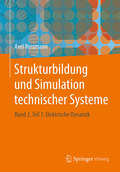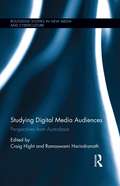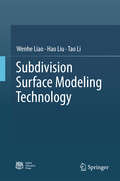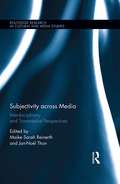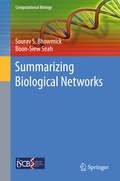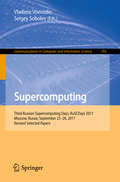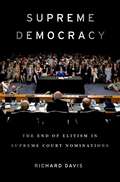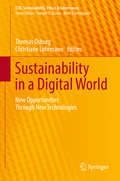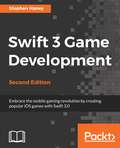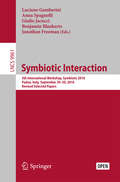- Table View
- List View
Strukturbildung und Simulation technischer Systeme: Band 2, Teil 1: Elektrische Dynamik
by Axel RossmannTeil 1 des zweiten Bandes behandelt die Zeit- und Frequenz-Abhängigkeit elektrischer Systeme aus technischer Sicht. Mechanische Systeme bestehen aus Massen, Federn und Dämpfern. Elektrische Schaltungen bestehen aus Spulen, Kondensatoren und Widerständen. Mit diesen Bauelementen lassen sich die Basis-Systeme in Physik und Technik realisieren, wie zum Beispiel Oszillatoren.
Studying Animal Languages Without Translation: An Insight from Ants
by Zhanna ReznikovaThe Author of this new volume on ant communication demonstrates that information theory is a valuable tool for studying the natural communication of animals. To do so, she pursues a fundamentally new approach to studying animal communication and “linguistic” capacities on the basis of measuring the rate of information transmission and the complexity of transmitted messages.Animals’ communication systems and cognitive abilities have long-since been a topic of particular interest to biologists, psychologists, linguists, and many others, including researchers in the fields of robotics and artificial intelligence. The main difficulties in the analysis of animal language have to date been predominantly methodological in nature. Addressing this perennial problem, the elaborated experimental paradigm presented here has been applied to ants, and can be extended to other social species of animals that have the need to memorize and relay complex “messages”. Accordingly, the method opens exciting new dimensions in the study of natural communications in the wild.
Studying Digital Media Audiences: Perspectives from Australasia (Routledge Studies in New Media and Cyberculture)
by Craig Hight Ramaswami HarindranathAlthough many digital platforms continue to appropriate and reconfigure familiar forms of media experience, this is an environment which no longer consistently constructs an identifiable 'mass' audience in the terms understood by twentieth century audience researchers. The notion of 'audiencing' takes on different characteristics within a digital environment where platforms encourage users to upload, share and respond to content, while the platforms themselves monetise the digital traces of this activity. This environment demands new ways of thinking about audience and user engagement with media technologies, and raises significant questions on methods of conceiving and researching audience-users. This volume addresses ongoing debates in the field of audience research by exploring relevant conceptual and methodological issues concerning the systematic study of digital audiences. Drawing from work conducted by researchers based in Australia and New Zealand, the book uses theoretical frameworks and case study material which are of direct relevance to audience researchers globally.
Studying Digital Media Audiences: Perspectives from Australasia (Routledge Studies in New Media and Cyberculture)
Although many digital platforms continue to appropriate and reconfigure familiar forms of media experience, this is an environment which no longer consistently constructs an identifiable 'mass' audience in the terms understood by twentieth century audience researchers. The notion of 'audiencing' takes on different characteristics within a digital environment where platforms encourage users to upload, share and respond to content, while the platforms themselves monetise the digital traces of this activity. This environment demands new ways of thinking about audience and user engagement with media technologies, and raises significant questions on methods of conceiving and researching audience-users. This volume addresses ongoing debates in the field of audience research by exploring relevant conceptual and methodological issues concerning the systematic study of digital audiences. Drawing from work conducted by researchers based in Australia and New Zealand, the book uses theoretical frameworks and case study material which are of direct relevance to audience researchers globally.
Stützpunktbasierter Ansatz zur Vorhersage von Bauteiltemperaturkollektiven im Thermomanagement des Gesamtfahrzeugs (Wissenschaftliche Reihe Fahrzeugtechnik Universität Stuttgart)
by Jan EllerJan Eller beschreibt eine Möglichkeit zur frühzeitigen simulativen Vorhersage von Häufigkeitsverteilungen der Temperatur von Bauteilen im Unterbodenbereich über die Lebensdauer eines Fahrzeugs. Bisher konnten diese für die Bauteilprüfung notwendigen Daten nur in späten Entwicklungsphasen experimentell ermittelt werden. Exemplarisch wird diese Methode an Elastomerbauteilen im Vorderachsbereich hergeleitet. Basierend auf Dauerlaufinformationen kann das Bauteiltemperaturkollektiv über Stützpunkte beschrieben werden. Die benötigtenTemperaturinformationen werden aus thermischen 3D-Gesamtfahrzeugsimulationen abgeleitet, während die Häufigkeitsinformation des Stützpunkts durch das jeweilige Auftreten im repräsentierten Fahrprofil definiert wird.
Subdivision Surface Modeling Technology
by Wenhe Liao Hao Liu Tao LiThis book offers a comprehensive introduction to Subdivision Surface Modeling Technology focusing not only on fundamental theories but also on practical applications. It furthers readers’ understanding of the contacts between spline surfaces and subdivision surfaces, enabling them to master the Subdivision Surface Modeling Technology for analyzing subdivision surfaces. Subdivision surface modeling is a popular technology in the field of computer aided design (CAD) and computer graphics (CG) thanks to its ability to model meshes of any topology. The book also discusses some typical Subdivision Surface Modeling Technologies, such as interpolation, fitting, fairing, intersection, as well as trimming and interactive editing. It is a valuable tool, enabling readers to grasp the main technologies of subdivision surface modeling and use them in software development, which in turn leads to a better understanding of CAD/CG software operations.
Subjectivity across Media: Interdisciplinary and Transmedial Perspectives (Routledge Research in Cultural and Media Studies)
by Jan-Noël Thon Maike Sarah ReinerthMedia in general and narrative media in particular have the potential to represent not only a variety of both possible and actual worlds but also the perception and consciousness of characters in these worlds. Hence, media can be understood as "qualia machines," as technologies that allow for the production of subjective experiences within the affordances and limitations posed by the conventions of their specific mediality. This edited collection examines the transmedial as well as the medium-specific strategies employed by the verbal representations characteristic for literary texts, the verbal-pictorial representations characteristic for comics, the audiovisual representations characteristic for films, and the interactive representations characteristic for video games. Combining theoretical perspectives from analytic philosophy, cognitive theory, and narratology with approaches from phenomenology, psychosemiotics, and social semiotics, the contributions collected in this volume provide a state-of-the-art map of current research on a wide variety of ways in which subjectivity can be represented across conventionally distinct media.
Subjectivity across Media: Interdisciplinary and Transmedial Perspectives (Routledge Research in Cultural and Media Studies)
by Jan-Noël Thon Maike Sarah ReinerthMedia in general and narrative media in particular have the potential to represent not only a variety of both possible and actual worlds but also the perception and consciousness of characters in these worlds. Hence, media can be understood as "qualia machines," as technologies that allow for the production of subjective experiences within the affordances and limitations posed by the conventions of their specific mediality. This edited collection examines the transmedial as well as the medium-specific strategies employed by the verbal representations characteristic for literary texts, the verbal-pictorial representations characteristic for comics, the audiovisual representations characteristic for films, and the interactive representations characteristic for video games. Combining theoretical perspectives from analytic philosophy, cognitive theory, and narratology with approaches from phenomenology, psychosemiotics, and social semiotics, the contributions collected in this volume provide a state-of-the-art map of current research on a wide variety of ways in which subjectivity can be represented across conventionally distinct media.
Summarizing Biological Networks (Computational Biology #24)
by Sourav S. Bhowmick Boon-Siew SeahThis book focuses on the data mining, systems biology, and bioinformatics computational methods that can be used to summarize biological networks. Specifically, it discusses an array of techniques related to biological network clustering, network summarization, and differential network analysis which enable readers to uncover the functional and topological organization hidden in a large biological network. The authors also examine crucial open research problems in this arena. Academics, researchers, and advanced-level students will find this book to be a comprehensive and exceptional resource for understanding computational techniques and their applications for a summary of biological networks.
Supercomputing: Third Russian Supercomputing Days, RuSCDays 2017, Moscow, Russia, September 25–26, 2017, Revised Selected Papers (Communications in Computer and Information Science #793)
by Vladimir Voevodin Sergey SobolevThis book constitutes the refereed proceedings of the Third Russian Supercomputing Days, RuSCDays 2017, held in Moscow, Russia, in September 2017.The 41 revised full papers and one revised short paper presented were carefully reviewed and selected from 120 submissions. The papers are organized in topical sections on parallel algorithms; supercomputer simulation; high performance architectures, tools and technologies.
The Support of Decision Processes with Business Intelligence and Analytics: Insights on the Roles of Ambidexterity, Information Processing and Advice
by Martin KowalczykIn his research, Martin Kowalczyk empirically investigates the challenges of designing and establishing successful decision support with Business Intelligence and Analytics (BI&A). The results from his work elucidate organizational and individual perspectives of BI&A support in decision processes. The organizational perspective considers the processual aspects of decision making and addresses process phases, roles and their interactions. The individual perspective reflects upon decision making of human individuals including their cognition and behaviors involved in decision making. The support of managerial decision making with BI&A gains increasing priority for many businesses in their desire to achieve better decision outcomes and improved organizational performance.
Supreme Democracy: The End of Elitism in Supreme Court Nominations
by Richard DavisIn the nineteenth and early twentieth centuries, Supreme Court nominations were driven by presidents, senators, and some legal community elites. Many nominations were quick processes with little Senate deliberation, minimal publicity and almost no public involvement. Today, however, confirmation takes 81 days on average-Justice Antonin Scalia's former seat has already taken much longer to fill-and it is typically a media spectacle. How did the Supreme Court nomination process become so public and so nakedly political? What forces led to the current high-stakes status of the process? How could we implement reforms to improve the process? In Supreme Democracy: The End of Elitism in the Supreme Court Nominations, Richard Davis, an eminent scholar of American politics and the courts, traces the history of nominations from the early republic to the present. He examines the component parts of the nomination process one by one: the presidential nomination stage, the confirmation management process, the role of the Senate Judiciary Committee, and the increasing involvement over time of interest groups, the news media, and public opinion. The most dramatic development, however, has been the democratization of politics. Davis delves into the constitutional underpinnings of the nomination process and its traditional form before describing a more democratic process that has emerged in the past half century. He details the struggle over image-making between supporters and opponents intended to influence the news media and public opinion. Most importantly, he provides a thorough examination of whether or not increasing democracy always produces better governance, and a better Court. Not only an authoritative analysis of the Supreme Court nomination process from the founding era to the present, Supreme Democracy will be an essential guide to all of the protracted nomination battles yet to come.
Sustainability, Green IT and Education Strategies in the Twenty-first Century (Green Energy and Technology)
by Tomayess Issa Pedro Isaias Theodora IssaThis work presents and discusses the latest approaches and strategies for implementing Sustainability and Green IT into higher education and business environments. Following the global financial crisis in 2007/2008, businesses began to struggle coping with the increased IT/IS cost and their environmental footprint. As a consequence, action by universities to incorporate sustainability and ‘Green IT’ as parts of their teaching and learning materials, acknowledging their importance for global and local businesses, is being increasingly implemented. The book addresses the cooperation and coordination between academics and practitioners needed in order to achieve the changes required to obtain sustainability.Intended for researchers, lecturers and post-graduate students, as well as professionals in the Information Society and ICT and education sectors, and policy makers.
Sustainability in a Digital World: New Opportunities Through New Technologies (CSR, Sustainability, Ethics & Governance)
by Thomas Osburg Christiane LohrmannThis book offers a comprehensive introduction to the different emerging concepts in the innovative area of sustainability and digital technology. More than 20 leading thinkers from the fields of digitalization, strategic management, sustainability and organizational development share clearly structured insights on the latest developments, advances and remaining challenges concerning the role of sustainability in an increasingly digital world. The authors not only introduce a profound and unique analysis on the state-of-the art of sustainability and digital transformation, but also provide business leaders with practical advice on how to apply the latest management thinking to their daily business decisions. Further, a number of significant case studies exemplify the issues discussed and serve as valuable blueprints for decision makers.
Sustainable Design and Manufacturing 2017: Selected papers on Sustainable Design and Manufacturing (Smart Innovation, Systems and Technologies #68)
by Giampaolo Campana Robert J. Howlett Rossi Setchi Barbara CimattiThis volume includes papers presented at the 4th International Conference on Sustainable Design and Manufacturing (SDM-17) held in Bologna, Italy, in April 2017. The conference covered a wide range of topics from cutting-edge sustainable product design and service innovation, sustainable processes and technology for the manufacturing of sustainable products, sustainable manufacturing systems and enterprises, decision support for sustainability, and the study of the societal impact of sustainability including research for circular economy. Application areas are wide and varied, and the book provides an excellent overview of the latest research and development in the area of Sustainable Design and Manufacturing.
Sustained Simulation Performance 2017: Proceedings of the Joint Workshop on Sustained Simulation Performance, University of Stuttgart (HLRS) and Tohoku University, 2017
by Michael M. Resch Wolfgang Bez Erich Focht Michael Gienger Hiroaki KobayashiThis book presents the state of the art in High Performance Computing on modern supercomputer architectures. It addresses trends in hardware and software development in general, as well as the future of High Performance Computing systems and heterogeneous architectures. The contributions cover a broad range of topics, from improved system management to Computational Fluid Dynamics, High Performance Data Analytics, and novel mathematical approaches for large-scale systems. In addition, they explore innovative fields like coupled multi-physics and multi-scale simulations. All contributions are based on selected papers presented at the 24th Workshop on Sustained Simulation Performance, held at the University of Stuttgart’s High Performance Computing Center in Stuttgart, Germany in December 2016 and the subsequent Workshop on Sustained Simulation Performance, held at the Cyberscience Center, Tohoku University, Japan in March 2017.
Swift 3 Game Development - Second Edition
by Stephen HaneyEmbrace the mobile gaming revolution by creating popular iOS games with Swift 3.0 About This Book • Create and design games for iPhone and iPad using SpriteKit and Swift 3.0 • Learn the core fundamentals of SpriteKit game development and mix and match techniques to customize your game • This step-by-step practical guide will teach you to build games from scratch using little-known tips and strategies for maximum fun Who This Book Is For If you wish to create and publish fun iOS games using Swift, then this book is for you. You should be familiar with basic programming concepts. However, no prior game development or Apple ecosystem experience is required. What You Will Learn • Deliver powerful graphics, physics, and sound in your game by using SpriteKit • Set up the scene using the new capabilities of the scene editor and custom classes • Maximize gameplay with little-known tips and strategies for fun and repeatable action • Make use of animations, graphics, and particles to polish your game • Understand the current mobile monetization landscape to choose the best option for your own situation • Integrate your game with Game Center so that your players can share their high scores and achievements • Publish your game to the App Store and enjoy people playing your games In Detail Swift is the perfect choice for game development. Developers are intrigued by Swift 3.0 and want to make use of new features to develop their best games yet. Packed with best practices and easy-to-use examples, this book leads you step by step through the development of your first Swift game. This book starts by introducing SpriteKit and Swift's new features that can be used for game development. After setting up your first Swift project, you will build your first custom class, learn how to draw and animate your game, and add physics simulations. Then, you will add the player character, NPCs, and powerups. To make your game more fun and engaging, you will learn how to set up scenes and backgrounds, build fun menus, and integrate with Apple Game Center to add leaderboards and achievements. You will then make your game stand out by adding animations when game objects collide, and incorporate proven techniques such as the advanced particle system and graphics. Finally, you will explore the various options available to start down the path towards monetization and publish your finished games to the App Store. By the end of this book, you will be able to create your own iOS games using Swift and SpriteKit. Style and approach This project-based guide is engaging with a visually-rich approach rather than a text-heavy approach. With every chapter containing practical examples, you will understand how Swift programming works and make the most of the new features in version 3.0.
Swift 3 Object-Oriented Programming - Second Edition
by Gaston C. HillarImplement object-oriented programming paradigms with Swift 3.0 and mix them with modern functional programming techniques to build powerful real-world applications About This Book • Leverage the most efficient object-oriented design patterns in your Swift applications • Write robust, safer, and better code using the blueprints that generate objects • Build a platform with object-oriented code using real-world elements and represent them in your apps Who This Book Is For This book is for iOS and macOS developers who want to get a detailed practical understanding of object-oriented programming with the latest version of Swift: 3.0. What You Will Learn • Write high-quality and easy-to-maintain reusable object-oriented code to build applications for iOS, macOS, and Linux • Work with encapsulation, abstraction, and polymorphism using Swift 3.0 • Work with classes, instances, properties, and methods in Swift 3.0 • Take advantage of inheritance, specialization, and the possibility to overload or override members • Implement encapsulation, abstraction, and polymorphism • Explore functional programming techniques mixed with object-oriented code in Swift 3.0 • Understand the differences between Swift 3.0, previous Swift versions, and Objective-C code In Detail Swift has quickly become one of the most-liked languages and developers' de-facto choice when building applications that target iOS and macOS. In the new version, the Swift team wants to take its adoption to the next level by making it available for new platforms and audiences. This book introduces the object-oriented paradigm and its implementation in the Swift 3 programming language to help you understand how real-world objects can become part of fundamental reusable elements in the code. This book is developed with XCode 8.x and covers all the enhancements included in Swift 3.0. In addition, we teach you to run most of the examples with the Swift REPL available on macOS and Linux, and with a Web-based Swift sandbox developed by IBM capable of running on any web browser, including Windows and mobile devices. You will organize data in blueprints that generate instances. You'll work with examples so you understand how to encapsulate and hide data by working with properties and access control. Then, you'll get to grips with complex scenarios where you use instances that belong to more than one blueprint. You'll discover the power of contract programming and parametric polymorphism. You'll combine generic code with inheritance and multiple inheritance. Later, you'll see how to combine functional programming with object-oriented programming and find out how to refactor your existing code for easy maintenance. Style and approach This simple guide is packed with practical examples of solutions to common problems. Each chapter includes exercises and the possibility for you to test your progress by answering a quiz
Swift 4 Programming Cookbook: 50 task-oriented recipes to make you productive with Swift 4
by Keith MoonOver 50 recipes to help you quickly and efficiently build applications with Swift 4 and Xcode 9 About This Book • Write robust and efficient code and avoid common pitfalls using Swift 4 • Get a comprehensive coverage of the tools and techniques needed to create multi-platform apps with Swift 4 • Packed with easy-to-follow recipes, this book will help you develop code using the latest version of Swift Who This Book Is For If you are looking for a book to help you learn about the diverse features offered by Swift 4 along with tips and tricks to efficiently code and build applications, then this book is for you. Basic knowledge of Swift or general programming concepts will be beneficial. What You Will Learn • Explore basic to advanced concepts in Swift 4 Programming • Unleash advanced features of Apple's Xcode 9 IDE and Swift Playgrounds • Learn about the conditional statements, loops, and how to handle errors in Swift • Define flexible classes and structs using Generics, and learn about the advanced operators, and create custom operators • Explore functionalities outside of the standard libraries of Swift • Import your own custom functionality into Swift Playgrounds • Run Swift on Linux and investigate server-side programming with the server side framework Vapor In Detail Swift 4 is an exciting, multi-platform, general-purpose programming language. Being open source, modern and easy to use has made Swift one of the fastest growing programming languages. If you interested in exploring it, then this book is what you need. The book begins with an introduction to the basic building blocks of Swift 4, its syntax and the functionalities of Swift constructs. Then, introduces you to Apple's Xcode 9 IDE and Swift Playgrounds, which provide an ideal platform to write, execute, and debug the codes thus initiating your development process. Next, you'll learn to bundle variables into tuples, set order to your data with an array, store key-value pairs with dictionaries and you'll learn how to use the property observers. Later, explore the decision-making and control structures in Swift and learn how to handle errors in Swift 4. Then you'll, examine the advanced features of Swift, generics and operators, and then explore the functionalities outside of the standard library, provided by frameworks such as Foundation and UIKit. Also, you'll explore advanced features of Swift Playgrounds. At the end of the book, you'll learn server-side programming aspect of Swift 4 and see how to run Swift on Linux and then investigate Vapor, one of the most popular server-side frameworks for Swift. Style and approach Each recipe addresses a specific problem, with a detailed discussion that explains the solution and offers insight into how it works.
Swift 4 Protocol-Oriented Programming - Third Edition: Bring predictability, performance, and productivity to your Swift applications
by Jon HoffmanBuild fast and powerful applications by harnessing the power of protocol-oriented programming in Swift 4 About This Book • Leverage the power of protocol-oriented programming in your applications and learn from real-world use cases • Create a flexible code base with protocols and protocol extensions • Leverage the power of generics in Swift 4 to create very flexible frameworks Who This Book Is For This book is for Swift developers who want to learn and implement protocol-oriented programming in their real-world applications.. What You Will Learn • Understand the differences between object-oriented programming and protocol-oriented programming • Explore the different types that Swift offers and what pitfalls to avoid • Delve into generics and generic programming • Learn how to implement Copy-On-Write within your custom types • Implement several design patterns in a protocol-oriented way • Design applications by prioritizing the protocol first and the implementation types second In Detail Swift has become the number one language used in iOS and macOS development. The Swift standard library is developed using protocol-oriented programming techniques, generics, and first-class value semantics; therefore, every Swift developer should understand these powerful concepts and how to take advantage of them in their application design. This book will help you understand the differences between object-oriented programming and protocol-oriented programming. It will demonstrate how to work with protocol-oriented programming using real-world use cases. You will gain a solid knowledge of the various types that can be used in Swift and the differences between value and reference types. You will be taught how protocol-oriented programming techniques can be used to develop very flexible and easy-to-maintain code. By the end of the book, you will have a thorough understanding of protocol-oriented programming and how to utilize it to build powerful and practical applications. Style and approach This book is written for developers who learn best by working with code, so every concept discussed in this book is reinforced with real code examples.
Swift in the Cloud
by Leigh Williamson John Ponzo Patrick Bohrer Ricardo Olivieri Karl Weinmeister Samuel KallnerWrite and run Swift language programs in the Cloud Written by the team of developers that has helped bring the Swift language to Cloud computing, this is the definitive guide to writing and running Swift language programs for cloud environment. In Swift in the Cloud, you'll find full coverage of all aspects of creating and running Swift language applications in Cloud computing environments, complete with examples of real code that you can start running and experimenting with today. Since Apple introduced the Swift language in 2014, it has become one of the most rapidly adopted computer programming languages in history—and now you too can start benefitting from using the same programming language for all components of a scalable, robust business software solution. Create server applications using Swift and run them on pay-as-you-go cloud infrastructure Quickly write and test Swift code snippets in your own cloud sandbox Use Docker containers to deploy Swift applications into multiple cloud environments without having to change code Grasp the elements and structure of the Swift.org open technology project Find out how to avoid the complexities of runtime configuration by using Cloud Foundry buildpacks for Swift Build high performing web applications and REST APIs with an open source Swift based web server framework Scale up your cloud services by running Swift modules in an asynchronous, open source, 'serverless' cloud environment Whether you are already using Swift to build mobile applications or a seasoned web developer, Swift in the Cloud will help you leverage server-side Swift to power your next generation of applications.
Swift in the Cloud
by Leigh Williamson John Ponzo Patrick Bohrer Ricardo Olivieri Karl Weinmeister Samuel KallnerWrite and run Swift language programs in the Cloud Written by the team of developers that has helped bring the Swift language to Cloud computing, this is the definitive guide to writing and running Swift language programs for cloud environment. In Swift in the Cloud, you'll find full coverage of all aspects of creating and running Swift language applications in Cloud computing environments, complete with examples of real code that you can start running and experimenting with today. Since Apple introduced the Swift language in 2014, it has become one of the most rapidly adopted computer programming languages in history—and now you too can start benefitting from using the same programming language for all components of a scalable, robust business software solution. Create server applications using Swift and run them on pay-as-you-go cloud infrastructure Quickly write and test Swift code snippets in your own cloud sandbox Use Docker containers to deploy Swift applications into multiple cloud environments without having to change code Grasp the elements and structure of the Swift.org open technology project Find out how to avoid the complexities of runtime configuration by using Cloud Foundry buildpacks for Swift Build high performing web applications and REST APIs with an open source Swift based web server framework Scale up your cloud services by running Swift modules in an asynchronous, open source, 'serverless' cloud environment Whether you are already using Swift to build mobile applications or a seasoned web developer, Swift in the Cloud will help you leverage server-side Swift to power your next generation of applications.
Swift iOS Programming for Kids
by Jim Campagno Steffen D. SommerUnleash your child's developer potential through fun projects and help them learn how to create iOS apps in Swift About This Book • Children can express their creativity while learning through interactive Swift Playgrounds • Empower children to think critically about problems • Learning programming basics can help children gain confidence in problem solving • Help children put their imagination into action building their first iOS app Who This Book Is For Children who are curious about the technology we use in our daily lives and want to know how it works can use this book to learn about programming and building their first iOS app. No prior programming experience is necessary. What You Will Learn • Basic programming and coding fundamentals • Write code using the fun and interactive Swift Playgrounds app • Make animations, including creating your own starry night • Utilise functions by making pizza in code • Create an interactive toy bin • Learn how to use control flow statements to further enhance your toy bin • Build a simple movie night app working with tableviews and arrays In Detail This book starts at the beginning by introducing programming through easy to use examples with the Swift Playgrounds app. Kids are regularly encouraged to explore and play with new concepts to support knowledge acquisition and retention – these newly learned skills can then be used to express their own unique ideas. Children will be shown how to create their first iOS application and build their very own movie night application. Style and approach This is a project-based guide with an engaging tone that uses a visually rich format. It explains the concepts in clear language and uses lots of pictures, cartoons, and examples. There is a set of practical exercises to be completed.
Symbiotic Interaction: 5th International Workshop, Symbiotic 2016, Padua, Italy, September 29–30, 2016, Revised Selected Papers (Lecture Notes in Computer Science #9961)
by Luciano Gamberini Anna Spagnolli Giulio Jacucci Benjamin Blankertz Jonathan FreemanThis book is published open access under a CC BY license.This book constitutes the proceedings of the 5th International Workshop on Symbiotic Interaction, Symbiotic 2016, held in Padua, Italy, in October 2016.The 12 full papers and 3 short papers presented in this volume were carefully reviewed and selected from 23 submissions. The idea of symbiotic systems put forward in this workshop capitalizes on the computers’ ability to implicitly detect the users goals, preferences or/and psycho-physiological states and thereby enhancing human-computer interaction (HCI). The papers present an overview of the symbiotic relationships between humans and computers with emphasis on user-driven research on symbiotic systems, adaptive systems, implicit input data, physiological computing and BCI, but also on understanding the nature of the interdependence and agency between computers and humans more broadly.
